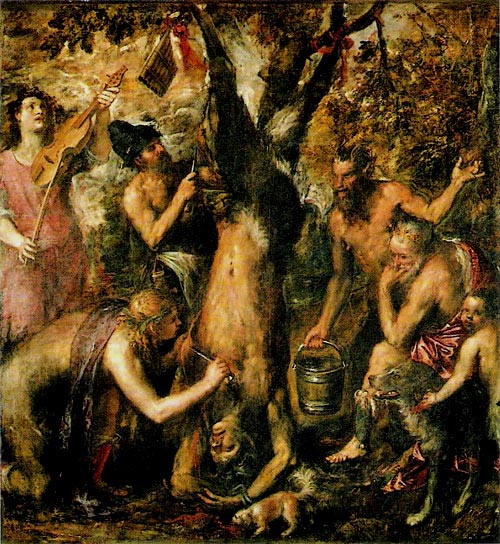| The Flaying of Marsyas | |
|---|---|
 |
|
| Artist | Titian |
| Year | c. 1570-1576 |
| Medium | Oil on canvas |
| Location | National Museum of Kroměříž, Czech Republic |
| Dimensions | 83 in × 81 in |
| 212 cm × 207 cm | |
| Famous Paintings by Titian | |
| Rape of Europa | |
| Sacred and Profane Love | |
| Pastoral Concert | |
| The Assumption of the Virgin | |
| Christ Carrying the Cross | |
| The Flaying of Marsyas | |
| Allegory of Prudence | |
| The Worship of Venus | |
| Self-Portrait | |
| View Complete Works |
The Flaying of Marsyas is one of the Venetian master’s great, late works of art. Titian modified and perfected details on this particular painting for over a decade. It was completed in the summer of 1576 just before his death, suffering from the plague. In his old age, his mysterious style has been interpreted in many ways. It is contemplated that this painting style was due to being tired, old, deathly ill, impatient, or some other change in style of brushstroke. It is an oil on canvas painting, portraying pain and cruelty, and is now in the State Museum in Kromeriz.
A Story of Ovid Behind The Flaying of Marsyas
This painting has a look of frenzied, dark activity, cluttered with figures of beasts and humans, who are participating in the rite of painfully and slowly tearing flesh from the bones of the central figure, Marsyas. The story behind the painting is from Ovid, which centers around a contest between a satyr, Marsyas, and Apollo, the mythical god.
Marsyas challenges Apollo to a contest of playing reeds musically. The conditions are that the victor can inflict his choice of punishment on the loser. Marsyas does not win the contest, and Apollo chooses flaying Marsyas, or stripping the flesh from his bones. The story from Ovid’s writings is one of cruelty, and Titian’s painting depicts Ovid’s written description of the flaying scene.
The Flaying of Marsyas Style
This painting is composed in such a manner, that it should be viewed from a distance as opposed to close inspection. Titian used broad, sweeping brushstrokes, with sparsely interjected color splotches. Using loose, and somewhat agitated brushstrokes with specks of white interwoven, everything appears to glisten and move. Some speculate whether the painting was indeed finished, or whether this is how the newer-style use of the brush appeared.
Titian’s paintings were sometimes portraits religious themes and mythological scenes. It is interpreted by some, that the seated, bearded, kingly-looking character in The Flaying of Marsyas is actually a portrait of Titian himself, just looking onward. Although this is a cruel theme, Titian was an artist who transformed the written word into fabulous art. The Flaying of Marsyas was a labor of love for a very old and infirmed, yet determined master of painting.